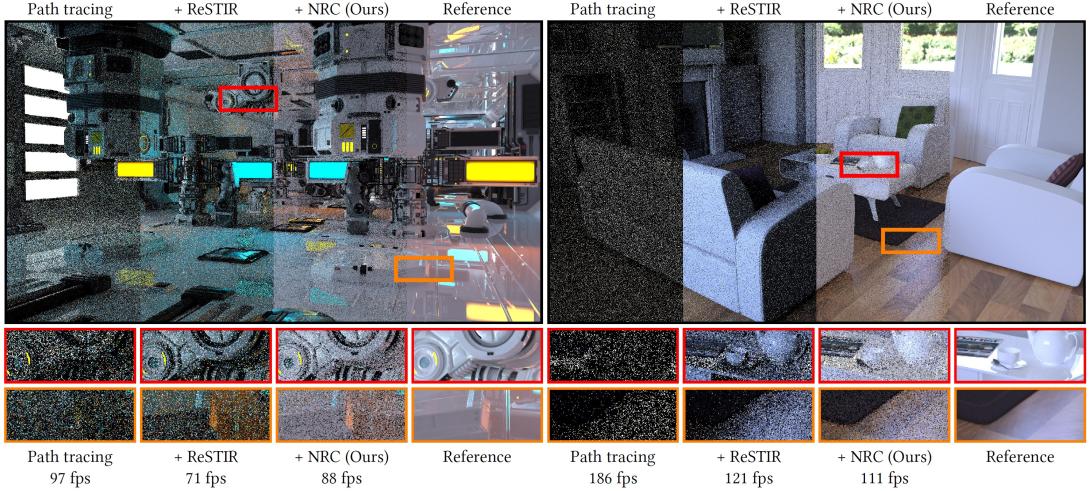Cyberpunk 2077 May Add a New Nvidia Denoiser to Improve Image Quality
Noise is a big problem with ray tracing and path tracing

@CapFrameX on Twitter reports that Cyberpunk 2077 might be adding support for Nvidia's Real-Time Neural Radiance Caching for Path Tracing technology (NRC) in the near future. This should significantly improve the image quality of Cyberpunk 2077's new RT overdrive feature and reduce the noise in some of the game's Path Tracing effects.
NRC is a relatively new Nvidia technology that was announced back in 2021. The key aspect of the technology is that it is powered by a neural network to approximate the radiance field in a path-tracing pipeline. According to Nvidia, this AI technology adapts to scenes on the fly with a training method that functions during the rendering process.
The AI can handle fully dynamic scenes and does not make educated guesses on a scene's lighting, geometry, or materials. The AI model is also self-training and can simulate infinite-bounce transport after training with just a few bounce updates.
To demonstrate, Nvidia shared a video and an image in its original presentation detailing the advantages of NRC compared to normal path tracing with no denoising filters and ReSTIR (another type of denoiser). In both media formats, NRC outperformed ReSTIR by a very noticeable amount and provided a level of image quality that is very close to the reference image.
Sadly, the addition of NRC ensures a performance cost of approximately 2.6ms at 1080p, according to Nvidia. Hence, it is not a free quality upgrade compared to pure path tracing with no denoiser. However, Nvidia demonstrates that NRC is around 9% to 23% faster than ReSTIR, so there will be an advantage.
We don't know how NRC will operate in Cyberpunk 2077, but we can safely gauge that it will noticeably improve the game's overall image quality in RT Overdrive mode, and make certain lighting effects clearer with fewer artifacts. In addition, if Cyberpunk 2077 is using ReSTIR right now as its current denoiser, we can also expect a healthy frame rate improvement if the game transitions to NRC.
Get Tom's Hardware's best news and in-depth reviews, straight to your inbox.

Aaron Klotz is a contributing writer for Tom’s Hardware, covering news related to computer hardware such as CPUs, and graphics cards.
-
PlaneInTheSky It's not just noise, there's a whole laundry list of issues with raytracing.Reply
You can't have degenerate triangles in any mesh because raytracing can't handle those.
You have to find a solution to the "fireflies" artefacts in a scene. This is not the same as noise, they're little specks of bounced light from ray that found a lightsource when they shouldn't have, so they become little white spots in the scene.
Caustics is also a major problem for raytracing. For anything related with water, Disney uses photon mapping instead.
Cyberpunk gets lots of money and help from Nvidia to find solutions to these raytracing problems. But I can tell you with confidence that the average game developer has no time, money, or desire to do all of this.
I loved when Nvidia introduced raytracing and sites like PCGamer and DigitalFoundry said it was easy to implement because "that"s how light works"...not sure what they were smoking when they wrote that, but they have clearly never implemented a raytracing algorithm. -
hotaru251 I mean....why waste resources on the RTX mode that is nearly unplayable by anyone w/o a xx90 series gpu?Reply
thats the stuff that should be focused on later down line when the userbase generally can run it not when only a minority can. -
zx128k RIP AMD RX 6000 performance numbers. The RX 6000 series fine wine aging. Fits on-chip memory. Cache on AMD cards are useless.Reply
8WEcE-mRoik -
edzieba ReplySadly, the addition of NRC ensures a performance cost of approximately 2.6ms at 1080p, according to Nvidia. Hence, it is not a free quality upgrade compared to pure path tracing with no denoiser. We don't know how NRC will operate in Cyberpunk 2077, but we can safely gauge that it will noticeably improve the game's overall image quality in RT Overdrive mode, and make certain lighting effects clearer with fewer artifacts.
By increasing denoiser quality, the same output image quality can be achieved with a lower sampling density. As sampling density is the major performance driver (the fewer rays you need, the more frames you can complete with a given ray budget) improving denoiser quality has a direct performance impact. -
evdjj3j Reply
I play in RTX on my 2070 no problems.hotaru251 said:I mean....why waste resources on the RTX mode that is nearly unplayable by anyone w/o a xx90 series gpu?
thats the stuff that should be focused on later down line when the userbase generally can run it not when only a minority can. -
hotaru251 Reply
specifically in the ray tracing overdrive (which this article is about).evdjj3j said:I play in RTX on my 2070 no problems.
w/o enabling dlss which makes it look worse its not ideal and hitting 30-40 fps with drops in 20's isn't enjoyable for many ppl.
and thats 1080p.
